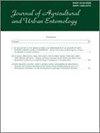First Record of Myelobia smerintha (Hübner) (Lepidoptera: Pyralidae: Crambinae) in Sugarcane in Colombia1
Q2 Agricultural and Biological Sciences
引用次数: 0
Abstract
Sugarcane (Saccharum officinarum L.) cultivation occupies approximately 474,559 ha in Colombia (Cenicaña 2011). The Hoya del Río Suárez region (Boyacá and Santander Departments in north-central Colombia) produced 100,799 tons of sugar, which accounted for 40% of the total volume of sugarcane grown for the production of panela (MADR-CCI 2012). Other major production areas are the Departments of Cundinamarca (24%), Antioquia (20%), Huila (6%), and Nariño (11%) (MADR-CCI 2012). Panela is a molded rectangular block of sugar produced by heating and concentrating sugarcane juice. Colombia is the second largest producer of panela in the world after India (Rodríguez 2000). Production of sugarcane is affected by different insect pests, and borers in the genusDiatraea (Lepidoptera: Pyralidae: Crambinae) are considered the most damaging and commonly encountered (Bustillo-Pardey 2013). Larvae of Crambinae feed upon roots and leaves of sugarcane. They bore into grasses, sedges, and rushes (Stehr 1987, Landry 1995). Larvae of Myelobia smerintha (Hübner) (Lepidoptera: Pyralidae: Crambinae) are known to bore inside stem internodes of bamboo (Guadua aculeateRupr. Ex E. Fourn.) and taquara (Bambusa tuldoides Munro) (both Poaceae), two species closely related to sugarcane (Neto & Ramos-Elorduy 2006, Landry et al. 2015). In this paper, we report the detection of M. smerintha using sugarcane as a developmental host. This is not the first record of M. smerintha in Colombia (Bleszynski 1967), but it is the first record of sugarcane as a host plant for this giant Crambinae species. In November 2015 and February 2016, a total of 10 unidentified borer larvae were collected manually from sugarcane plants in the municipality of Villeta, Cundinamarca Department. The sugarcane plants were grown near a corridor of guadua, Guadua angustifolia Kunth (Poaceae). The larvae were taken to the哥伦比亚甘蔗Myelobia smerintha(Hübner)的首次记录1
哥伦比亚的甘蔗种植面积约为474559公顷(Cenicaña,2011年)。Hoya del Río Suárez地区(哥伦比亚中北部的Boyacá和Santander省)生产了100799吨糖,占用于生产panela的甘蔗总产量的40%(MADR-CCI,2012年)。其他主要生产区是Cundinamarca省(24%)、Antioquia省(20%)、Huila省(6%)和Nariño省(11%)(MADR-CCI 2012)。Panela是一种通过加热和浓缩甘蔗汁制成的长方形糖块。哥伦比亚是仅次于印度的世界第二大镶板生产国(Rodríguez,2000年)。甘蔗生产受到不同害虫的影响,而梨科的蛀虫被认为是最具破坏性和最常见的害虫(Bustillo Pardey,2013)。Crambinae的幼虫以甘蔗的根和叶为食。它们钻入草、莎草和灯心草中(Stehr 1987,Landry 1995)。已知丝纹Myelobia smerintha(Hübner)(鳞翅目:梨科:Crambinae)的幼虫在竹子(Guadua aculateRup.Ex E.Fourn.)和竹(Bambusa tuldides Munro)的茎节间内繁殖,这两个物种与甘蔗关系密切(Neto&Ramos Elorduy 2006,Landry等人2015)。在本文中,我们报道了以甘蔗为发育宿主检测到的smerintha。这并不是哥伦比亚首次记录到M.smerintha(Bleszynski 1967),但这是首次记录到甘蔗作为这种巨型Crambinae物种的寄主植物。2015年11月和2016年2月,Cundinamarca省Villeta市的甘蔗厂共人工采集了10只身份不明的蛀虫幼虫。甘蔗生长在番石榴的走廊附近,番石榴是狭叶番石榴科植物。幼虫被带到
本文章由计算机程序翻译,如有差异,请以英文原文为准。
求助全文
约1分钟内获得全文
求助全文
来源期刊

The Journal of Agricultural and Urban Entomology
Agricultural and Biological Sciences-Insect Science
CiteScore
1.40
自引率
0.00%
发文量
2
期刊介绍:
The Journal of Agricultural and Urban Entomology (JAUE) (Journal of Agricultural Entomology, Jan 1984 - Oct 1998 volumes 1-15) is published under the auspices of the South Carolina Entomological Society (SCES). The Journal publishes contributions of original research concerning insects and other arthropods of agricultural and urban importance to include those affecting humans, livestock, poultry, and wildlife. JAUE is particularly dedicated to the publication of articles and notes pertaining to applied entomology, although it will accept suitable contributions of a fundamental nature related to agricultural and urban entomology.
 求助内容:
求助内容: 应助结果提醒方式:
应助结果提醒方式:


